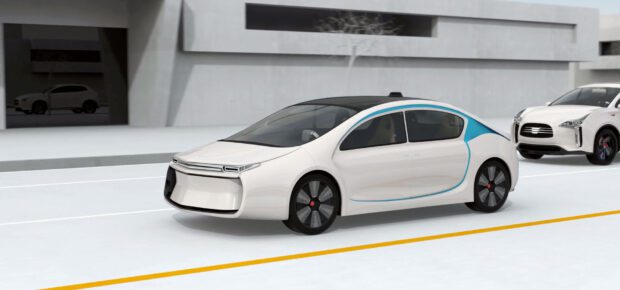July 13, 2022
The modern automobile is already enormously complex, with many cars relying on many more lines of code than fighter jets. Cars are enormously complicated and the systems that allow vehicles to operate autonomously will add even more complexity.
That complexity may lead to thorny cybersecurity challenges with real-world consequences. Unlike a classic cyberattack in which data is stolen or ransomware locks down a system, cyberattacks on cars could lead to property damage or injuries.
According to a recent Morning Consult survey, just 9% of U.S. respondents trust autonomous vehicles “a lot.” Opinions are slightly more favorable among younger respondents, and in China, Brazil and South Korea for example. Chief among the concerns: safety.
We asked a few cybersecurity experts to pinpoint some of the biggest cyber-physical challenges when it comes to autonomous vehicles.
MORE SENSORS, NETWORKS, VULNERABILITIES
IEEE Fellow Guoliang Xing sees a mix of communications systems and a complex operating environment as key challenges to autonomous vehicle security:
- Different Tech, Different Standards – “Vehicles are equipped with increasingly diverse connectivities, such as short-range interfaces like Bluetooth, cellular interfaces like 5G as well as vehicle-to-Everything (V2X) and vehicle-to-vehicle (V2V) interfaces. “These wireless technologies work at very different frequencies and follow different standards. How to protect them from cyber and physical attacks in a holistic manner is a major challenge.”
- Increased Surface Area – “More and more control units and sensors on vehicles may become targets of attacks. For instance, the perceptions of millimeter wave radar, camera and LiDAR can be manipulated by roadside objects modified by attackers.
- External Threats – “Threats can come from other cars or roadside infrastructure. Our streets are installed with more and more intelligent infrastructure like smart lampposts, which may present the risk of malicious monitoring and even attacks on the safety of cars and pedestrians. More importantly, such attacks can be launched at a massive scale, posing a major threat to our cities in the future.”
PRIVACY ON THE MOVE
IEEE Member Marcos Simplicio notes that privacy has been an important issue that will be integrated into several global regulations and standards. He says that autonomous vehicles may also need robust identity management systems to anonymize user information.
“The whole idea is that you don’t have to authenticate yourself toward the network using the same key all the time,” Simplicio said. “Along your path, you change identity – how the system sees you, so even the entities that control all the communications, they are not aware of who you are all the time.”
KEEPING SOFTWARE UP-TO-DATE
Consumers are notorious for their inattention to software updates, which often include critical updates to security. It’s why most smartphone companies, device makers and apps push updates to users automatically, rather than relying on consumers to do so proactively. IEEE Senior Member Aiyappan Pillai said that automakers need to take the same approach.
“It is important not to confuse customers with too many choices and options to maintain the software,” Pillai said. “The process must be simple and the expectation with autonomous vehicles, even though it could be unrealistic, is for it to take care of itself.
“Autonomous systems can adapt mechanisms used in the aerospace industry for monitoring engines, something similar to that system should also be set for auto update at rationed and defined times. However safety and security-critical patches shall be pushed instantaneously with new information. Each update shall be applied appropriately, keeping safety and security in focus.”
LEARN MORE:
The IEEE Learning Network has tons of resources to help you advance your career. If you are interested in learning more about the latest in autonomous driving technology, check out these course programs on automotive cybersecurity and autonomous vehicle technology.
Video Transcript
What are the technology and security challenges of autonomous vehicles?
Guoliang Xing, IEEE Fellow: “Vehicles are equipped with increasingly diverse connectivities, such as short range interfaces, Bluetooth, cellular interfaces, like 5G, as well as V2X and V2V interface. These wireless technologies work at very different frequencies and follow different standards. How to protect them from cyber and physical attacks in a holistic manner is a major challenge.
Marcos Simplicio, IEEE Member: “It’s actually an important aspect that has been, is being considered by many standards, both in the U.S. and in Europe. The whole idea is that you don’t have to authenticate yourself towards the network using the same key all the time. I mean, along your path, you change your identity, how the system sees you. So, even the entities that control all the communications, they are not aware of who you are all the time. You can be tracked by a small path of your trajectory, but not all the time so the system cannot be abused. For example, to track vehicles or high value targets, or be abused somehow for spying on people.”





 Meaningful Momentum or Running in Place?
Meaningful Momentum or Running in Place? AI Through Our Ages
AI Through Our Ages Liquid Infrastructure: Our Planet's Most Precious Resource
Liquid Infrastructure: Our Planet's Most Precious Resource The Impact of Technology in 2025
The Impact of Technology in 2025 Quantum and AI: Safeguards or Threats to Cybersecurity?
Quantum and AI: Safeguards or Threats to Cybersecurity? Why AI Can't Live Without Us
Why AI Can't Live Without Us Bits, Bytes, Buildings and Bridges: Digital-Driven Infrastructure
Bits, Bytes, Buildings and Bridges: Digital-Driven Infrastructure Impact of Technology in 2024
Impact of Technology in 2024 Emerging AI Cybersecurity Challenges and Solutions
Emerging AI Cybersecurity Challenges and Solutions The Skies are Unlimited
The Skies are Unlimited Smart Cities 2030: How Tech is Reshaping Urbanscapes
Smart Cities 2030: How Tech is Reshaping Urbanscapes Impact of Technology 2023
Impact of Technology 2023 Cybersecurity for Life-Changing Innovations
Cybersecurity for Life-Changing Innovations Smarter Wearables Healthier Life
Smarter Wearables Healthier Life Infrastructure In Motion
Infrastructure In Motion The Impact of Tech in 2022 and Beyond
The Impact of Tech in 2022 and Beyond Cybersecurity, Technology and Protecting Our World
Cybersecurity, Technology and Protecting Our World How Technology Helps us Understand Our Health and Wellness
How Technology Helps us Understand Our Health and Wellness The Resilience of Humanity
The Resilience of Humanity Harnessing and Sustaining our Natural Resources
Harnessing and Sustaining our Natural Resources Creating Healthy Spaces Through Technology
Creating Healthy Spaces Through Technology Exceptional Infrastructure Challenges, Technology and Humanity
Exceptional Infrastructure Challenges, Technology and Humanity The Global Impact of IEEE's 802 Standards
The Global Impact of IEEE's 802 Standards Scenes of our Cyber Lives: The Security Threats and Technology Solutions Protecting Us
Scenes of our Cyber Lives: The Security Threats and Technology Solutions Protecting Us How Millennial Parents are Embracing Health and Wellness Technologies for Their Generation Alpha Kids
How Millennial Parents are Embracing Health and Wellness Technologies for Their Generation Alpha Kids Space Exploration, Technology and Our Lives
Space Exploration, Technology and Our Lives Global Innovation and the Environment
Global Innovation and the Environment How Technology, Privacy and Security are Changing Each Other (And Us)
How Technology, Privacy and Security are Changing Each Other (And Us) Find us in booth 31506, LVCC South Hall 3 and experience the Technology Moon Walk
Find us in booth 31506, LVCC South Hall 3 and experience the Technology Moon Walk Virtual and Mixed Reality
Virtual and Mixed Reality How Robots are Improving our Health
How Robots are Improving our Health IEEE Experts and the Robots They are Teaching
IEEE Experts and the Robots They are Teaching See how millennial parents around the world see AI impacting the lives of their tech-infused offspring
See how millennial parents around the world see AI impacting the lives of their tech-infused offspring Take the journey from farm to table and learn how IoT will help us reach the rising demand for food production
Take the journey from farm to table and learn how IoT will help us reach the rising demand for food production Watch technical experts discuss the latest cyber threats
Watch technical experts discuss the latest cyber threats Explore how researchers, teachers, explorers, healthcare and medical professionals use immersive technologies
Explore how researchers, teachers, explorers, healthcare and medical professionals use immersive technologies Follow the timeline to see how Generation AI will be impacted by technology
Follow the timeline to see how Generation AI will be impacted by technology Learn how your IoT data can be used by experiencing a day in a connected life
Learn how your IoT data can be used by experiencing a day in a connected life Listen to technical experts discuss the biggest security threats today
Listen to technical experts discuss the biggest security threats today See how tech has influenced and evolved with the Games
See how tech has influenced and evolved with the Games Enter our virtual home to explore the IoT (Internet of Things) technologies
Enter our virtual home to explore the IoT (Internet of Things) technologies Explore an interactive map showcasing exciting innovations in robotics
Explore an interactive map showcasing exciting innovations in robotics Interactively explore A.I. in recent Hollywood movies
Interactively explore A.I. in recent Hollywood movies Get immersed in technologies that will improve patients' lives
Get immersed in technologies that will improve patients' lives